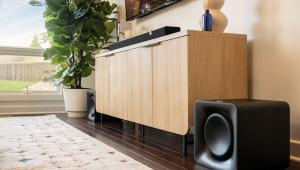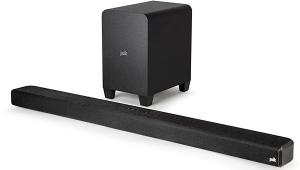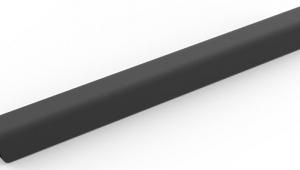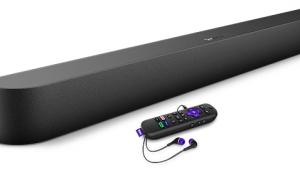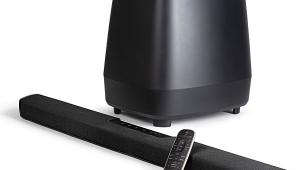Bowers & Wilkins Panorama 3 Atmos Soundbar Review Page 2
A better sounding-track was "Bad Guy" by Billie Ellish, which had enough bass energy to set things shaking in the credenza that supported the soundbar. Ellish's vocals were big and clear, and the detail in percussion, including some crisp finger snaps, was outstanding. Still, bass-heavy music like this or "Give Me Back My Girl" by Fiction Family is not the Panorama's musical forte. Goosing the bass added impact to the tom toms and bass drum kicks that start this track, but you can't expect miracles with loud rock or EDM.
Despite the claimed 43Hz low-end limit, test tones showed that the bar started to drop off quickly below 60Hz in my room and was down about 10dB by 50 Hz. With the bass slider at its maximum +6dB position, there was additional energy starting around 125 Hz and stretching down to where it still had some impact around 40Hz. But bass was still about 20dB down from its peak at that point. Still, any usable bass below 60Hz in a standalone soundbar should be viewed with awe.
Dynamics were excellent but also ultimately limited. Musical peaks maxed out around 99dB and, despite the excellent DSP, you can definitely hear strain if you lean hard on the volume. Fortunately, there's plenty of loudness to enjoy within the soundbar's considerable limits.
On the other side of the coin, the Panorama 3 was right at home with jazz. "You Look Good to Me" by the Oscar Peterson Trio starts with unadorned piano scales, delicate triangle dings, and the very slow and resonant pulls of a bow on the double bass. Aside from the modestly compressed soundstage width and depth, it sounded as good as I've heard it. Instrument positions were distinct with Peterson's piano at center stage, drums and percussion at the left, and the bass slightly right of center. The detail and timbre were dead on and goosebump-inducing. I could easily hear into the rattle on the brushed snare drum and, as the track evolved into a boogie woogie riff, I heard Peterson use the piano's pedals to dampen the decay of notes. Likewise, the tapped cymbal kept its shimmer throughout and the Panorma offered beautifully rich and well-defined plucked bass.

Pop ballads were another strong suit. Adele's cover of Bob Dylan's "Make You Feel My Love" rendered a huge and pure vocal that sat forward of a luscious and equally large piano that emanated from behind Adele and seemed to envelope her. The subtle dynamic build of her voice on the crescendos was well-tracked, with only slightly more compression than I've heard on better systems but with the emotion still intact. And when the strings joined in, they sounded natural and textured.
I sampled some of Tidal's extensive Atmos playlists. The Atmos version of The Doors classic "Riders On The Storm" was a great test track, with its rain and storm sound effects providing an immersive backdrop as they emanated from above. The mix for Taylor Swift's "This Love" (Taylor's Version) intentionally placed the vocal high up in the stage and slightly out into the room; her sweet, syrupy delivery floated above the bar. And another jazz track, "Moanin'" by Art Blakely and the Jazz Messengers, took full advantage of the height channels by expanding the recording space around the instruments and putting you in the room with the musicians. Once again, the natural timbre of the instruments—trumpet, sax, piano, cymbal taps—helped make this track even more convincing.
You can get lost listening to music with the Panorama 3—something I don't often say about a soundbar—but it was also superb with TV and movies. Disney's Jungle Cruise is a charming live-action caper set during World War II that stars Emily Blunt and Dwayne Johnson; think equal parts Indiana Jones and African Queen. It proved an excellent test of the Panorama 3's mettle. The Dolby Atmos soundtrack on the Disney+ stream was outstanding, filled with snappy dialogue, all manner of jungle sounds, gunfire, explosions, fist fights, and an adventurous orchestral score. The bar delivered a big image that stretched only slightly beyond its physical boundaries but went fully up to the ceiling, placing the occasional effect out in the room. As an example, rain falling in the jungle provided a nice broad canopy of ambience—nothing like the deep coverage you'd get with additional rear surround speakers, but reasonably omnipresent and lifelike.

One of the movie's high points was a prolonged scene in which Blunt and Johnson's characters escape a tiny Brazilian harbor town and set course down the Amazon after a dynamic foot chase through the village and pursuit on the water by a German U-boat. Over a period of 8 minutes, viewers experience a flock of flapping parrots, punches and kicks in hand-to-hand combat, the clang of a pot on one unfortunate pursuer's noggin and the thunk of a coconut on another's, the sizzle of a hand forced onto a stove (ouch!), a troop of screaming monkeys, the mechanical pumping of the boat's steam engine, the explosion of a torpedoed building, and the whining of metal as the submarine runs aground.
I was astonished at the convincing detail and cleanliness of it all, the fine dynamics, and the excellent timbre of the horn-driven score. My only complaint, and it is a small one, is that the soundtrack and effects could sometimes overwhelm the dialogue in this and other scenes throughout the movie. I turned up the treble and bass to bring out more definition in the voices and add a touch more heft to the bottom end, which despite its limitations was more than passable by movie-watching standards and more than you would normally expect from a standalone soundbar. Still, a voice-boost button would have been nice.
Conclusion
It's hard to end a review of the Panorama 3 without acknowledging its primary competition in this price range, the $899 Sonos Arc, which I reviewed in 2020. Though it doesn't quite have the B&W's pedigree and finesse with music, it remains a fine audiophile soundbar that adds side-firing drivers from its endcaps that can take advantage of room reflections to help spread the front image wider than what the Panorama 3 can achieve on its own. Plus, you can add surrounds and a subwoofer, albeit at considerable cost. As a standalone bar, the Arc delivered comparable deep bass performance that also started to fall off below 60 Hz in my room.
Still, it's impressive to see how the Panorama 3 stays true to its audiophile roots and commitment to simplicity while delivering sonics of this caliber, all without a subwoofer or surrounds. Short of adding those extra speakers, I'm not sure you could get better performance from such a trim and elegant soundbar.



